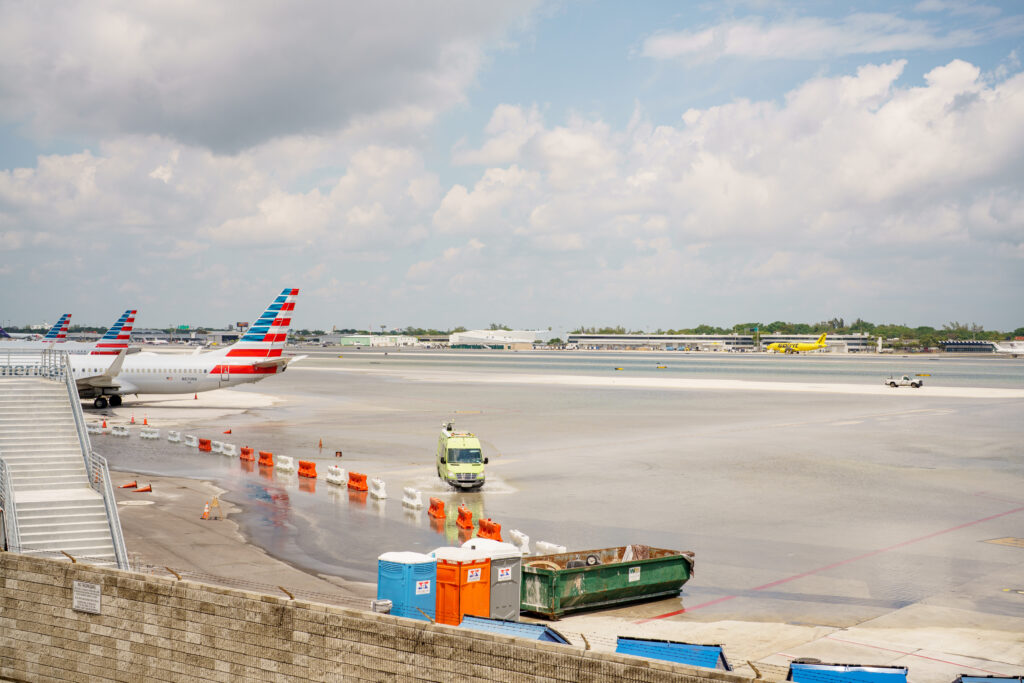By Patrick Ceres, Lion Point Engineering
I was shocked last April when I saw footage on social media of someone taking a leisurely swim in floodwaters in downtown Fort Lauderdale. According to the National Weather Service, the Fort Lauderdale metro area experienced more than 20 inches of rainfall over a 12-hour period, resulting in massive flooding turning city streets into waterways. Hundreds of abandoned vehicles leached petroleum products and combined with untreated wastewater (sewage) in the floodwaters. The floodwaters were a potpourri of stuff that you would want to avoid at all costs.
As an environmental engineer, I wondered what was happening in the subsurface with the migration of environmental contaminants that we couldn’t see. Specifically, I thought about our underground storage tank (UST) program and the untold damage happening beneath our feet. USTs are commonly found at gas stations and airports. They typically store petroleum products such as gasoline and diesel fuel. When they leak, their contents pose a harm to the environment. For example, benzene, a major component of gasoline, is a known carcinogen that has also been linked to a wide range of adverse health effects.
Florida has one of the highest numbers of open leaking USTs sites (referred to as LUSTs) in the United States at about 9,272 sites. According to Florida Department of Environmental Protection’s (FDEP’s) records, as of December 2023, the number of LUST sites awaiting cleanup in the tri-county area are approximately 1,039 (Miami-Dade County); 578 (Broward County); and 462 (Palm Beach County).
Florida’s LUST cleanup record is dismal when compared to other metro areas. For example, the California State Water Resources Control Board’s GeoTracker indicates that Los Angeles County has about 380 LUST sites awaiting cleanup. According to the U.S. Census Bureau, Broward County has about a fifth of the population and occupies a little more than a fourth of the area of L.A. County.

In South Florida’s tri-county area, the average age of these unaddressed releases is 19 years. There is a finite amount of money to address cleanup each year and a shallow groundwater table in our area complicates remedial efforts.
On the matter of prioritization for cleanup, the FDEP uses a scoring method that gives a score of 0 (lowest priority) to 100 (highest) based on: 1) the presence of free product; 2) proximity to drinking water wells; 3) product type; and 4) permeability/quality of the aquifer. The FDEP scoring guidance has not changed for more than 30 years, since the program was enacted in the late 1980s.
The scoring method is in drastic need of updating to one that is more closely aligned with environmental justice and a changing climate. One of the areas most impacted during the April and November 2023 rainfall events was Edgewood in Fort Lauderdale. Edgewood and its surrounding areas (Fort Lauderdale International Airport and Port Everglades) contain about 30% of LUST sites awaiting cleanup in Broward County. The Council on Environmental Quality’s Climate and Economic Justice Screening Tool indicates that the census tract in the neighborhood has a national projected flood risk in the 87th percentile, it ranks in the 85th percentile in low income, and it ranks in the 97th percentile for LUST releases. However, of the 95 LUSTs awaiting cleanup in the area, the average priority score is nine out of 100.
During heavy rainfall events, floodwater can enter LUSTs, pushing the fuel out. Additionally, with a rapid increase in the volume of water percolating into the subsurface over a short amount of time, groundwater spreads, and a rise in the water table can result in underlying contamination rising to the surface, where it settles into surface soils in backyards and nearby parks. Many environmental studies have found that increased flooding has been linked to an increase of soil contamination in urban areas.
The U.S. Environmental Protection Agency has made multi-billion-dollar investments in environmental justice; however, those investments haven’t had an impact on how our state-funded environmental cleanup is performed. We need more discussion on how extreme climate events impact legacy contamination and to enact safeguards to prevent our most vulnerable communities from bearing the brunt of environmental harm. Dissecting just one state-run cleanup program can help us see how to change course.
Patrick Ceres is a professional environmental engineer and the founder/managing principal of Lion Point Engineering, an environmental consulting firm based in Broward County. This opinion piece was originally published by the South Florida Sun Sentinel, which is a media partner of The Invading Sea.
If you are interested in submitting an opinion piece to The Invading Sea, email Editor Nathan Crabbe at nc*****@*au.edu. Sign up for The Invading Sea newsletter by visiting here.



